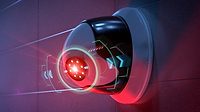Flow and occupancy management with LiDAR

Light detection and ranging (LiDAR) is best known as the technology that powers navigation in self-driving cars, but that’s not all it can do. LiDAR is used for everything from creating 3D elevation maps and river surveys to modeling pollution and helping archeologists detect long-lost relics hidden under vegetation. In security circles, LiDAR is emerging as an important tool to improve perimeter security, people flow and occupancy management as well.
What is LiDAR?
Just as radar uses electromagnetic radio waves to detect objects and sonar uses sound waves, LiDAR uses laser light. The LiDAR system emits a pulse of light and measures how long it takes for it to return to the sensor. By combining sensor data with GPS tracking and factoring in other variables like speed, an AI-powered LiDAR system can create precisely detailed, 3D representations of terrain and objects.
The real magic happens when you take this powerful technology and marry it with other data from video cameras, access control and sensors to detect, track and classify objects within a single unified security system.
Detailed information without compromising privacy
LiDAR maps objects in three dimensions, so you can also use it to gain new perspectives on familiar places. With sensor fusion, you can zoom down hallways, look around corners, flip an image upside down or view the environment from different angles.
With a unified security dashboard, LiDAR can also be used to improve intrusion detection. When an unauthorized entry into a controlled zone occurs, geolocation information from the LiDAR sensor can be used to identify the associated video feed and automatically signal mission control to manage the situation. Within the unified dashboard, security teams can get a full view from detection to resolution.
Because LiDAR sensors are unaffected by light levels or weather conditions, they can more accurately count people entering in and out of certain areas and determine the direction of traffic flow. LiDAR provides accurate, centimeter-level information not only about the number of objects detected, but also exactly where they are, what direction they are moving and at what speed. Since LiDAR does not capture video or biometric data, it provides detail without affecting any individual’s privacy.
How LiDAR can be used for occupancy management
Many companies are taking advantage of LiDAR’s highly accurate ability to count people to better understand the flow of employees and visitors and analyze how spaces within office buildings, retail complexes, stadiums, theme parks and other busy places are being used.
The technology is used to help improve the flow of people by tracking occupancy, crowd size and how long people stay within specific places. Since the COVID-19 pandemic, it has also been used to monitor crowd density.
Now that “physical distancing” has become part of our everyday lexicon, crowd management has become more important. In airports, LiDAR is used to detect the distance between people and send a notification if certain areas become too congested.
LiDAR data can also be used to improve guest experience. In retail stores, for example, LiDAR can be used to keep track of queue length. If too many people are waiting at the cash register, the system can alert the right people to open another till or redirect customers to a shorter line.
In one case, a quick-serve restaurant used LiDAR to get a better understanding of the customer journey. The company measured how long the average customer takes to enter, look at the menu, place an order, pay, pick up their food and exit. The goal was to use those insights to find new ways to speed up service, which would allow the restaurant to serve more customers and therefore boost profits.
A cost-effective solution
While the technology has been around for decades, until recently, its high cost limited innovation. The first LiDAR sensors on the market cost around $75,000 and were larger than the smartphones that now use LiDAR sensors inside them. Today, several manufacturers are aiming to get the price of some kinds of LiDAR sensors down below $100, which would make the technology accessible for even more applications.
But it isn’t just the hardware cost to consider. The total cost of ownership for a unified security system that uses LiDAR can be significantly cheaper than a conventional setup, especially when protecting a larger zone of control. A unified physical security system brings all sources of data — from sensors, cameras, access control and more — into a single interface.
With LiDAR sensors constantly scanning the area, an AI-powered unified system can direct cameras to track the movement of a particular object or suspected intruder. Drastically fewer video cameras are required since they don’t need to film everything at once and can be pointed in the right direction when needed using LiDAR’s location data. Less hardware and smarter systems reduce maintenance and labor costs, reducing the total cost of ownership for your security system compared to other devices.
When choosing a unified security system, look for a solution with a suite of products developed as one unit. With a truly open and unified platform, you can turn on or off different modules, but you can’t break the connections — because there aren’t any. Integrated systems are different. While you can connect one system to another, each system needs to be upgraded and maintained separately. Integrated systems are siloed, which can make consolidating large amounts of data time-consuming and inefficient.
More innovative uses for LiDAR on the horizon
LiDAR has proven to be an effective tool for a wide variety of use cases, including managing crowds, streamlining business processes, monitoring controlled zones and improving the guest experience. Yet, the innovation within this space is just beginning. If you’re considering adding LiDAR sensors to your physical security solution, choose a unified and open platform so you can take advantage of the next generation of hardware, software, plugins and integrations.
This article originally ran in Security, a twice-monthly security-focused eNewsletter for security end users, brought to you by Security magazine. Subscribe here.
Looking for a reprint of this article?
From high-res PDFs to custom plaques, order your copy today!





